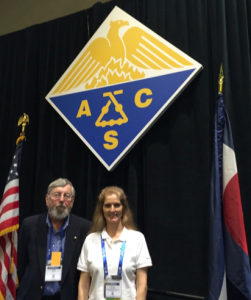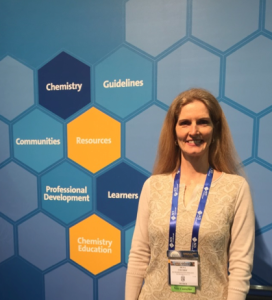It was exciting to participate in my first meeting of the ACS Council. There were over 450 people attending! And all of them are people who care about chemistry. My thanks go to John Berg, who has been a Councilor for the Sacramento Local Section for many years. He showed me the ropes and saved me a seat in the best section of the auditorium.
The Council meeting lasted for several hours. Most of the time was dedicated to reports from different committees and officers of the ACS. Some of the time was used for discussion and voting about items requiring input from the Council. I’ll summarize the highlights later in this report.
Although I mostly went to an array of ACS governance meetings, I did squeeze in a few other opportunies, including listening to two great talks. The first talk was presented by a scientist from Aegis Analytical Laboratory in Tennessee. Dr. Darcie Duckworth talked about how the company provides forensic reports about components of marijuana and its metabolic derivatives. In the second talk, Dr. Laura Kiessling spoke about how the carbohydrate features on the cell membranes of bacteria are very different from those of humans, and it is hoped that the differences can be exploited to defeat bacteria that are resistant to most antibiotics. I also went to the undergraduate research poster session to encourage those eager young people at the beginning of their scientific careers. And I went to the luncheon of the Alpha Chi Sigma national chemistry fraternity.
I attended a joint meeting of the Committee on Community Activities (CCA) and the Local Section Activities Committee (LSAC). They discussed how these committees are developing outreach materials and programs, including Chemists Celebrate Earth Day (CCED) and National Chemistry Week (NCW). And the 2016 National Chemistry Week theme was announced: Forensic Chemistry CSI! I’m really looking forward to that. I attended the meeting of the International Activities Committee and learned that new ACS chapters have formed in India and Taiwan, and by fall there will be new chapters in Peru, Brazil, and Nigeria. I attended the Western Region Board Meeting. Dr. Sandra Thompson told about the plans for the Western Region Meeting taking place in San Marcos, November 6-8. It sounds like it will be a great meeting with a lot of interesting features, including a symposium on intellectual property, and a social mixer with appetizers and beer tasting at Stone Brewing World Bistro & Gardens. The District VI Councilors Caucus shared a lot of information. I’ll include the financial portion below, because it was repeated in the reports to the Council meeting. Finally, I attended a Town Hall meeting where the four nominees for ACS President-Elect were able to speak about their plans and ideas for the presidency.
At last, you get to hear more about the Council meeting. The main action items were:
- Councilors voted to select two of four ACS President-Elect nominees to continue on as candidates in the final election:
- Bryan Balazs
- Allison Campbell
- Councilors voted to request that the Board of Directors delay adding a technical meeting fee to the regular national meeting registration fee until the Board presents an analysis including the projected break even fee.
- Councilors voted to approve the petitions to form new ACS chapters in India and Taiwan.
- Councilors voted to authorize the ACS membership dues proposed by the Committee on Budget and Finance.
At this point I’ll let you know about a couple more news items from the Council meeting. First, the ACS has a new Executive Director: Dr. Thomas Connelly, who formerly worked for DuPont. Second, the ACS was able to transfer some of its unrestricted assets into its pensions and benefits account in order to conform to funding guidelines. And third, many Councilors objected to the plan of the Committee on Meetings and Espositions to discontinue printing the national meeting program book for free, switching to a free app and the option to purchase a printed program book for $10 in advance or $20 at the door. Some Councilors protested that they found the app difficult to use, and that wi-fi often wasn’t available in the meeting rooms.
The committee reports showed that the ACS is working hard to advance the causes of chemistry in many ways. I’ve mentioned some examples earlier in this report, and I think Councilor John Berg will fill you in on the great work being done by the Committee on Economic and Professional Affairs (CEPA).
In conclusion, I’d like to thank all of you members of the Sacramento Local Section of the ACS for giving me the opportunity to represent you on the ACS Council.
Sincerely,
Dena Chubbic, Councilor


